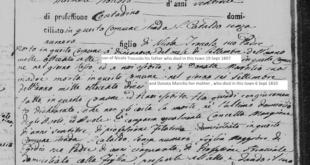The Italian Family of Yesterday and Today
Traditionally, married couples in Italy had large families and raised their children as part of an extended family of aunts, uncles, and cousins. In modern Italy, nuclear families tend to be smaller, but the language for how to describe children as they grow from a baby to an adult has not changed very much. Young boys and girls are called “the baby” — with “il bambino” for young boys or “la bambina” for young girls — until 5 or 6 years, long after we Americans would consider the “baby stage” has been completed. After this, Italians refer to children as “il ragazzino” or “la ragazzina.” The “ina” ending in Italian is a diminutive used to create a noun that means something is smaller than usual and also has an endearing connotation when the reference is to a person.
In the past, boys wore shorts called “pantaloni corti” until their family considered them “young men,” at which time they were allowed to wear pants. This tradition has been abandoned in Italy today but is evident as an integral part of the culture in the neorealist movies of post war Italy. Sometime in the teen years, boys and girls are referred to as “il ragazzo” and “la ragazza.” Eventually, these children “diventano grandi” or “grow up” and “il ragazzo” becomes “l’uomo” and “la ragazza” becomes “la donna.” The plural of l’uomo is irregular — gli uomini. The plural of la donna is regular —le donne.
The list below describes children as they grow from baby to adult. The Italian words that describe adult men and women, or “gli adulti,” also carry undertones that refer to the individual’s position in society. “Il signore” means “the gentleman.” This title confers on the individual the right to be addressed as “Signore,” either as a stand-alone title or as part of a surname, with the meaning of “Mr.” Similarly, “la signora” means “the (married) lady” and ‘Signora” means “Mrs,” while “la signorina” means both “young (unmarried) lady” and “Miss.”
In feudal times, the titles “Signori” and “Signore” were used to refer in general to “lords” and “ladies” and were originally granted to land owners, among many other important titles, such as Marchese, Principe, Principessa, etc. Today, if one wants to say, “Ladies and Gentleman” in Italian, the phrase would be “Signori e Signore.”
| la bambina/la bimba | the baby (female) |
| il ragazzino | the little boy |
| la ragazzina | the little girl |
| il ragazzo | the boy/the young man |
| la ragazza | the girl/the young woman* |
| l’uomo | the man |
| la donna | the woman |
| il signore | the gentleman |
| la signorina | the young lady (unmarried) |
| la signora | the lady (married) |
Please refer to the previous blog in this series, “Italian Possession” for how to refer to “my mother/father” “my daughter/son” “my sister/brother,” etc.
Some historical footnotes:
Opera fans may encounter the words fanciulla (the pretty young maiden) and gioconda (the lighthearted, merry girl), but fanciulla and gioconda are otherwise not used much anymore in Italy to describe young women.
*La Fanciulla del West (The Girl of the West) is an opera by Giacomo Puccini based on a play by the American author David Belasco.
*La Gioconda is a reference to the girl who plays the title role in the grand opera of the same name, composed by Amilcare Ponchielli, and is also used as the Italian name for the Mona Lisa.
Some Italian terms of endearment (and other not-so-endearing terms) used between family members
Italians are known for having an emotional temperament, perhaps due to classical works of opera, or in more recent times due to the types of Italian characters portrayed in movies and on TV. Although often exaggerated for dramatic purposes, generally speaking, Italians are not shy about expressing their feelings toward one another, and this is evident in the many well-knonw Italian terms of endearment.
For instance, a husband/wife or unmarried romantic couple commonly address each other as “amore” or “amore mio” for “my love.” This form of address can also be used for children.
Another common term of endearment in Italian is “caro/cara” for “dear” or “caro mio/cara mia,” for “my dear.” A cute child might be one’s “piccolino/a” or “cute little one.” If a child is crying or has had a minor injury, a mother might try to console the child by saying, “poverino(a)” for “poor little one.”
Among brothers and male friends, you may hear the Italian equivalent of the shortened form for brother, or “bro,” a common American way to refer to one’s real brother or a close friend that originated in the 1970s. The Italian equivalent “fra.”
Many more Italian terms of endearment can be found in a past blog in this series.
Sometimes, however, parents or others refer to their child in the negative. An “accio” ending can be added to ragazzo to make “ragazzaccio,” which means “bad boy.” Ragazzaccio also refers to one who is a rebel. “Bro” with a pejorative connotation is either “ragazzaccio” or “maschiaccio.”
Finally, a child or an adult in the family who needs a lot of attention can be described in a negative way as “bisognoso(a)” or “needy.” This adjective is related to the verb bisognare. You may remember from a previous blog “How to say, ‘I need in Italian'” that “Ho bisogno di” is one way to say, “I need…”
Some examples of how to use the adjective bisogno(a) are below:
Pietro è molto bisognoso. Lui ha bisogno di me ogni giorno, dalla mattina fino alle notte.
Peter is very needy. He needs me every day, from morning until night.
Maria è una figlia bisognosa! Ogni sera devo darle una mano con i suoi compiti!
Mary is a needy child! Every night I must help her (give her a hand) with her homework!
Giving instructions to children in Italian — what to do — and what not to do!
Parents often admonish their children to do one thing or another. As discussed in a previous blog about Familiar Italian commands, if you would like to direct a child to “Be good!” you can say, “Stai buono(a)!” or less commonly, “Stà buono(a)!” These sentences use the tu imperative form of the verb stare. Remember from our previous blog about buono that the ending of the adjective buono will change, depending on the gender of the person who is addressed.
To ask if a child is being good in Italian, one says, “Stai facendo il buono?” “Are you being good?”
“Sei bravo(a)” means the speaker is addressing someone who is has done something well. This is a common compliment given out from one adult to another, as well as from the an adult to a child.
Sometimes, on the other hand, children do things that they should not. If a child is making noise when he or she shouldn’t, their parent might say, “Non fare rumore!” or “Non fare chiasso!” for “Don’t make noise!” To ask a child or adult to be quiet, you can say, “Stop making noise!” or “Smettila di fare chiasso!” Another approach would be to say, “Stai zitto(a)!” for “Be quiet!”
Which brings us to the misbehaving child. Unfortunately, there are many different behaviors that can get a child into trouble or “mettere un bambino(a) nei guai”!
A classic line in any language is “What did I tell you about… (anything a child is not supposed to do). You will notice from the translation below, the Italian for this common expression, “Ti avevo chiesto di non…” is more like a negative statement than a question that does not translate directly into English.
Ti avevo chiesto di non… fare chiasso oggi?
What did I tell you about (literally what did I ask you about not)… making noise today?
Ti avevo chiesto di non… fare un casino quando abbiamo ospiti?
What did I tell you about… making a mess when we have guests?
Ti avevo chiesto di non… litigare con tua sorella?
What did tell you about… fighting with your sister?
Saying “sorry” in Italian
Of course, any improper behavior can be smoothed over by apologizing or “saying sorry,” which in Italian is “chiedere scusa.” Notice from the examples below that an Italian “asks” to be excused or forgiven,” while in English we say, “I’m sorry.”
You may remember from beginning Italian the phrase, “Mi dispiace,” which also means, “I’m sorry.” This catch-all phrase is a bit different than “chiedere scusa.” To say one is sorry by asking for forgiveness with “chiedere scusa” implies some sort of responsibility for one’s actions.
“Chiedere scusa” is also used in different situations from the Italian “Scusami” (familiar command) or “Mi scusi” (polite command) for “excuse me.” The last two commands are used in situations where one has inadvertently done or said something simple that they then want to “take back” or excuse themselves for, such as bumping into another in line or saying something embarrassing or incorrect.
For more serious situations, a parent can ask a child to say they are sorry using a familiar command. There is also a polite way for adults to ask each other to be excused using the subjunctive mood verb chieda. Dispiace and spiace also be used to make the same request.
Some example sentences to ask another for an apology in Italian:
Chiedimi scusa!
Say you are sorry (to me)! (familiar command)
Mi chieda scusa!
Say you are sorry to me! (polite command)
Voglio che tu chieda scusa.
I want you to say you are sorry. (polite request)
Dimmi che ti spiace!
Say you are sorry! (lit. tell me that you are sorry, familiar command)
Almeno di che ti dispiace.
At least (say that) you are sorry.
To say you are sorry for something you have done, use one of the following phrases:
Ti chiedo scusa.
I’m sorry. (for what I said or did to you, familiar singular)
Vi chiedo scusa.
I’m sorry. (for what I said or did to you all, familiar plural)
Or… maybe the adult or child is not sorry for what they’ve done. They may reply to a request to “say sorry” with:
Non voglio chiedere scusa!
I don’t want to say I’m sorry!
No, non chiedo scusa!
No, I won’t say I’m sorry!
Asking family “What are you doing?” and “What’s going on?” in Italian
The Italian words, “che,” “cosa,” and “che cosa” all mean “what” when they begin a sentence. To ask what someone is doing, or what is going on, we start with one of these pronouns and add what we are interested in knowing. Below is a list of easy-to-memorize common expressions in the familiar, as in every family, one needs to know, “What’s going on?”
| Che fai? | What are you doing? |
| Che cosa fai? | What are you doing? |
| Cosa c’è? | What’s going on?/What’s up? |
| Che cosa c’è? | What’s going on? |
| Che succede? | What is happening? |
| Che è successo? | What happened? |
If something is not going well, below are a few common phrases to use to express that feeling of helplessness that often comes with a difficult situation.
| Che casino! | What a mess! |
| Che dire? | What can I say? |
| Cosa posso fare? | What can I do? |
| Che si può fare? | What can one do? |
If whatever has happened is a problem that you hope can be fixed, use these encouraging phrases with future tense of andare and vedere:
Andrà tutto bene. Vedrai!
It will get better soon. You’ll see!
Of course, “Vedrai…” can be used in may other situations as well!
If you are not sure the situation will work out, or want to add a touch or irony, you can say, “Vedremo…” instead for “We’ll see…”
Both vedrai and vedremo are good future tense verbs to remember, even if you have not yet studied the future tense in Italian!
Asking family and friends, “Where are you?” or “Have you seen…?” in Italian
Probably the second most common question among family members after, “What is going on?” is “Where are you?” To answer is simple. Just use “ecco” for “here is/here are” and add the representative direct object pronoun to the end of the sentence (highlighted in red below).
Below are a few common question/answer scenarios that use dove (where) and ecco (here is/here are).
| Dove sei? | Where are you? |
| Eccomi! | Here I am! |
| Dov’è Pietro? | Where is Peter? |
| Dov’è lui? | Where is he? |
| Eccolo! | Here he is! |
| Dov’è Maria? | Where is Mary? |
| Dov’è lei? | Where is she? |
| Eccola! | Here she is! |
To ask a relative, neighbor or friend where another is, the question becomes, “Have you seen…?” And the answer, of course is in the affirmative or negative with, “Ho visto…” or “Non ho visto…” and the object pronoun added for him, her or them.
A few question/answer scenarios are listed below for male, female, and groups of people one may be searching for. Remember that the past participle must change to match the gender and number of people you are looking for when using a direct object with the passato prossimo past tense and avere is the helping verb! These ending have been highlighted in red.
If you don’t know the complicated grammar behind these phrases, it may helpful to memorize these four scenarios below given the daily use you will get out of these phrases!
| Hai visto Pietro? | Have you seen Peter? |
| Si, l’ho visto. | Yes, I have seen him. (single male) |
| Hai visto Maria? | Have you seen Mary? |
| Si, l’ho vista. | Yes, I have seen her. (single female) |
| Hai visto Pietro e Maria? | Have you seen Peter and Mary? |
| Si, li ho visti. | Yes, I have seen them. (group of males/males and females) |
| Hai visto Maria e Eva? | Have you seen Maria and Eva? |
| Si, le ho viste. | Yes, I’ve seen them. (group of females) |
A word of advice that might help one avoid having to look for a family member in the first place: give a warning before they leave not to be late with the simple line: Non fatti tardi! for “Don’t be late!”
Birthdays in Italian
The birthday of a family member is a day for celebration all over the world. In the past, Italian families celebrated birthdays according to the Catholic tradition, on the name day of the saint the individual was named after. Today, most Italians celebrate the day of their actual birth, although a second celebration may take place on the saint’s day as well if the family is religious. Usually, Italian families gather together and have a special meal for a family member’s birthday.
How do you wish someone a happy birthday in Italy and do Italians have a special song to sing to children, as we do in America? (Spoiler alert — they do!)
To wish someone a “Happy Birthday” in Italian, simply say, “Tanti auguri” or “Best wishes.” This phrase is taken from a longer sentence, that may be written in Birthday cards, “Tanti auguri di buon compleanno,” or “Best wishes for a happy birthday.”
In America, the song “Happy Birthday” is sung at the end of the meal with a cake topped with lighted candles. Italians use the same music as Americans for their “Happy Birthday” song, but instead of repeating the phrase “happy birthday” they repeat “tanti auguri a te” for “many good wishes to you” or “best wishes to you.” Then entire song is below. Try singing this easy phrase for your loved one’s next birthday!
Tanti auguri a te!
Tanti auguri a te!
Tanti auguri a (nome)!
Tanti auguri a te!
Remember how to use these simple
Italian phrases for the family
and I guarantee you will use these phrases every day!
For “All the Italian you need to enjoy your trip to Italy” click on the links for my Conversational Italian for Travelers books -Kathryn Occhipinti


 Fra Noi Embrace Your Inner Italian
Fra Noi Embrace Your Inner Italian






